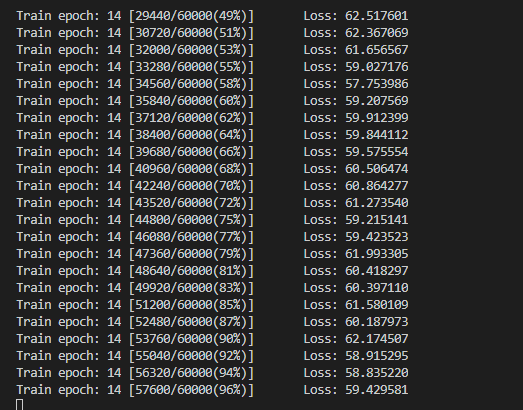import os
import argparse
import torch
import torch.utils.data
import torch.nn as nn
import torch.optim as optim
from torch.autograd import Variable
from torchvision import datasets, transforms
# import pdb
import matplotlib
matplotlib.use('Agg')
import matplotlib.pyplot as plt
import matplotlib.gridspec as gridspec
os.environ["CUDA_DEVICE_ORDER"]="PCI_BUS_ID" # see issue #152
os.environ["CUDA_VISIBLE_DEVICES"]="1"
os.environ["KMP_DUPLICATE_LIB_OK"]="TRUE"
print("Imported all libraries successfully!")
parser = argparse.ArgumentParser(description='PyTorch MNIST Example for CAE')
parser.add_argument('--batch-size', type=int, default=128, metavar='N',
help='input batch size for training (default: 64)')
parser.add_argument('--epochs', type=int, default=100, metavar='N',
help='number of epochs to train (default: 2)')
parser.add_argument('--no-cuda', action='store_true', default=False,
help='enables CUDA training')
parser.add_argument('--seed', type=int, default=1, metavar='S',
help='random seed (default: 1)')
parser.add_argument('--log-interval', type=int, default=10, metavar='N',
help='how many batches to wait before logging training status')
args = parser.parse_args()
args.cuda = not args.no_cuda and torch.cuda.is_available()
torch.manual_seed(args.seed)
if args.cuda:
torch.cuda.manual_seed(args.seed)
kwargs = {'num_workers': 5, 'pin_memory': True} if args.cuda else {}
Download_Minst = False # 已经下载过了设置为false
# 判断数据是否下载
if not(os.path.exists('data')) or not os.listdir('data'):
Download_Minst = True
# 下载数据
train_loader = torch.utils.data.DataLoader(
datasets.MNIST('data', train=True, download=True,
transform=transforms.ToTensor()),
batch_size=args.batch_size, shuffle=True, **kwargs)
test_loader = torch.utils.data.DataLoader(
datasets.MNIST('data', train=False, transform=transforms.ToTensor()),
batch_size=args.batch_size, shuffle=True, **kwargs)
lam = 1e-4
# 创建网络构架
class CAE(nn.Module):
def __init__(self):
super(CAE, self).__init__()
self.fc1 = nn.Linear(784, 400, bias = False) # Encoder
self.fc2 = nn.Linear(400, 784, bias = False) # Decoder
self.relu = nn.ReLU()
self.sigmoid = nn.Sigmoid()
def encoder(self, x):
h1 = self.relu(self.fc1(x.view(-1, 784)))
return h1
def decoder(self,z):
h2 = self.sigmoid(self.fc2(z))
return h2
def forward(self, x):
h1 = self.encoder(x)
h2 = self.decoder(h1)
return h1, h2
# Writing data in a grid to check the quality and progress
def samples_write(self, x, epoch):
_, samples = self.forward(x)
#pdb.set_trace()
samples = samples.data.cpu().numpy()[:16]
fig = plt.figure(figsize=(4, 4))
gs = gridspec.GridSpec(4, 4)
gs.update(wspace=0.05, hspace=0.05)
for i, sample in enumerate(samples):
ax = plt.subplot(gs[i])
plt.axis('off')
ax.set_xticklabels([])
ax.set_yticklabels([])
ax.set_aspect('equal')
plt.imshow(sample.reshape(28, 28), cmap='Greys_r')
if not os.path.exists('out/'):
os.makedirs('out/')
plt.savefig('out/{}.png'.format(str(epoch).zfill(3)), bbox_inches='tight')
#self.c += 1
plt.close(fig)
mse_loss = nn.BCELoss(size_average = False)
def loss_function(W, x, recons_x, h, lam):
mse = mse_loss(recons_x, x)
# Since: W is shape of N_hidden x N. So, we do not need to transpose it as
# opposed to #1
dh = h * (1 - h) # Hadamard product produces size N_batch x N_hidden
# Sum through the input dimension to improve efficiency, as suggested in #1
w_sum = torch.sum(Variable(W)**2, dim=1)
# unsqueeze to avoid issues with torch.mv
w_sum = w_sum.unsqueeze(1) # shape N_hidden x 1
contractive_loss = torch.sum(torch.mm(dh**2, w_sum), 0)
return mse + contractive_loss.mul_(lam)
model = CAE()
optimizer = optim.Adam(model.parameters(), lr = 0.0001)
if args.cuda:
model.cuda()
def train(epoch):
model.train()
train_loss = 0
for idx, (data, _) in enumerate(train_loader):
data = Variable(data)
if args.cuda:
data = data.cuda()
optimizer.zero_grad()
hidden_representation, recons_x = model(data)
# Get the weights
# model.state_dict().keys()
# change the key by seeing the keys manually.
# (In future I will try to make it automatic)
W = model.state_dict()['fc1.weight']
loss = loss_function(W, data.view(-1, 784), recons_x,
hidden_representation, lam)
loss.backward()
train_loss += loss.data[0]
optimizer.step()
if idx % args.log_interval == 0:
print('Train epoch: {} [{}/{}({:.0f}%)]\t Loss: {:.6f}'.format(
epoch, idx*len(data), len(train_loader.dataset),
100*idx/len(train_loader),
loss.data[0]/len(data)))
print('====> Epoch: {} Average loss: {:.4f}'.format(
epoch, train_loss / len(train_loader.dataset)))
model.samples_write(data,epoch)
for epoch in range(args.epochs):
train(epoch)
部分结果:

